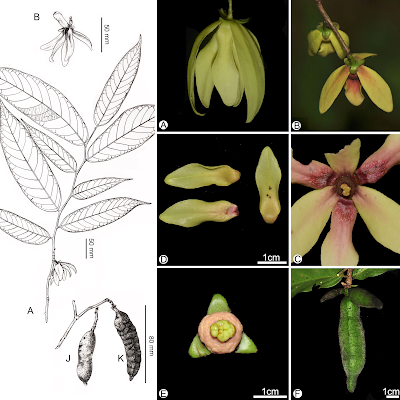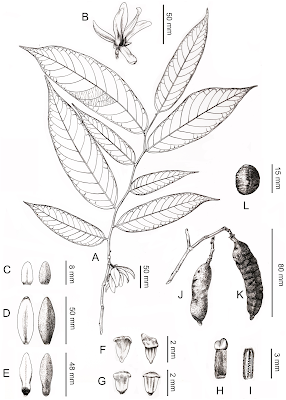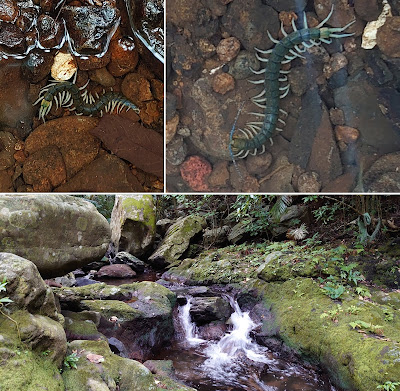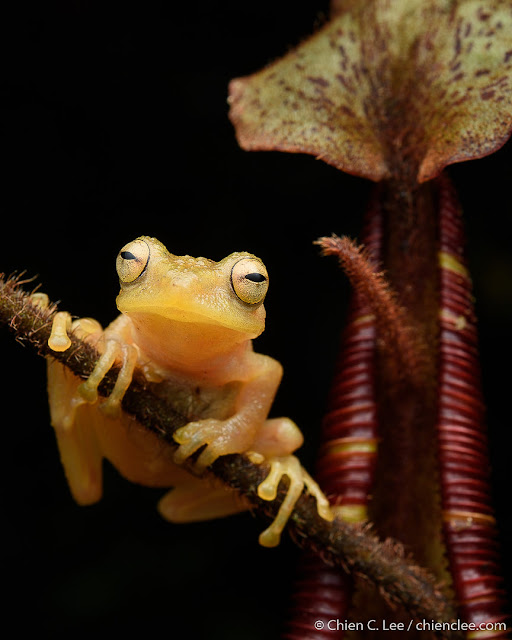[Most Recent Entries] [Calendar View]
Saturday, April 17th, 2021
| Time | Event | ||||
| 7:22a | [Botany • 2021] Meiogyne oligocarpa (Annonaceae) • A New Species from Yunnan, China
Meiogyne oligocarpa sp. nov. (Annonaceae) is described from Yunnan Province in Southwest China. It is easily distinguished from all previously described Meiogyne species by the possession of up to four carpels per flower, its bilobed, sparsely hairy stigma, biseriate ovules and cylindrical monocarps with a beaked apex. A phylogenetic analysis was conducted to confirm the placement of this new species within Meiogyne. Meiogyne oligocarpa represents the second species of Meiogyne in China: a key to the species of Meiogyne in China is provided to distinguish it from Meiogyne hainanensis. Paraffin sectioning was undertaken to study the anatomy of the corrugations on the inner petals of Meiogyne oligocarpa to verify whether they are glandular. Meiogyne oligocarpa B.Xue & Y.H.Tan, sp. nov. Diagnosis. Meiogyne oligocarpa is distinct among Meiogyne species in having a combination of characters, including up to four carpels per flower, bilobed sparsely hairy stigmas, cylindrical monocarps with a beaked apex, and seeds in two series. It is most similar to Meiogyne kanthanensis, but differs in having smaller leaves with more secondary veins, shorter pedicels, stigmas that are bilobed and distinctly less hairy, and cylindrical monocarps with a beaked apex. Etymology. The specific epithet reflects that the flower has few carpels (1–4) and hence the fruit has few monocarps (1–3). Bine Xue, Yun-Yun Shao, Chun-Fen Xiao, Ming-Fai Liu, Yongquan Li and Yun-Hong Tan. 2021. Meiogyne oligocarpa (Annonaceae), A New Species from Yunnan, China. PeerJ. 9:e10999. DOI:10.7717/peerj.10999 | ||||
| 8:22a | [Chilopoda • 2021] Scolopendra alcyona • A New Amphibious Species of the Genus Scolopendra Linnaeus, 1758 (Scolopendromorpha, Scolopendridae) from the Ryukyu Archipelago and Taiwan
Abstract In Japan and Taiwan, five valid species of the genus Scolopendra Linnaeus, 1758 have been described: S. morsitans Linnaeus, 1758, S. subspinipes Leach, 1816, S. mutilans Koch, 1878, S. japonica Koch, 1878, and S. multidens Newport, 1844. Recently, an undetermined species was found in the Ryukyu Archipelago and Taiwan. Using molecular phylogenetic analyses with mitochondrial COI and 16S rRNA and nuclear 28S rRNA and 18S rRNA genes as well as conventional morphological examination, we successfully discriminated this sixth species as an independent lineage from S. subspinipes, S. mutilans, and other named congeners from East and Southeast Asia. Therefore, the species was described as Scolopendra alcyona Tsukamoto & Shimano, sp. nov. Several situational evidences suggest that this species prefers streamside environments and exhibits amphibious behavior. Keywords: Myriapoda, Chilopoda, molecular phylogeny, morphology, semi-aquatic
Scolopendra alcyona Tsukamoto & Shimano, sp. nov. [New Japanese name: Ryûjin-ômukade (琉神大百足); new English name: Halcyon Giant Centipede] Etymology. This epithet “alcyona” derived from the name of a Greek mythological figure, “Alcyone”. In one version of the story, Alcyone was turned into a common kingfisher (halcyon bird) by Zeus ( Gresseth 1964). This epithet is a metaphor for halcyon bird-like jade green legs seen in the Okinawa-jima Island population, and its amphibious behavior. Sho Tsukamoto, Shimpei F. Hiruta, Katsuyuki Eguchi, Jhih-Rong Liao and Satoshi Shimano. 2021. A New Amphibious Species of the Genus Scolopendra Linnaeus, 1758 (Scolopendromorpha, Scolopendridae) from the Ryukyu Archipelago and Taiwan. Zootaxa. 4952(3); 465–494. DOI: 10.11646/zootaxa.4952.3.3 国内で143年ぶりのオオムカデの新種発見!渓流に潜む、翡翠色に輝く国内最大のオオ | ||||
| 11:19a | [Herpetology • 2021] Philautus nepenthophilus • Out of the Trap: A New Phytothelm‐breeding Species of Philautus (Anura: Rhacophoridae) and An Updated Phylogeny of Bornean Bush Frogs
Abstract Bush frogs of the genus Philautus are a species‐rich group of the Asian tree frogs Rhacophoridae, which are known for their diverse reproductive biology. Within Philautus, reproduction has been described via endotrophic tadpoles and by direct terrestrial development. Here, we provide results of phylogenetic analyses based on the most comprehensive sampling of Bornean Philautus to date. As a result of an integrative taxonomic study using mitochondrial and nuclear markers, along with morphological and bioacoustic data, we describe a spectacular new species of this genus from the island of Borneo. The ecology of the new species of Philautus is closely associated with the carnivorous pitcher plant, Nepenthes mollis. The unusually large eggs are laid in the fluid of the pitcher and the endotrophic tadpoles, characterized by reduced mouthparts, small oral orifice and large intestinal yolk mass, complete their development in this environment. Molecular data and synapomorphic larval characters support the sister group relationship of the new species to P. macroscelis: both belong to the early diverged lineages in the Philautus tree, whose phylogenetic relationships could not be fully resolved. The new record of endotrophic tadpoles challenges again the hypothesis that terrestrial direct development is the plesiomorphic mode in this genus. Further, we discuss the nature of the frog‐plant interaction that could represent a new case of mutualism. The frog provides the plant with a source of nitrogen by depositing yolk‐rich eggs in the liquid of the pitcher. The plant, on the other hand, offers an exclusively protected space for the development of tadpoles in a habitat that otherwise has few permanent bodies of water and many competing frog species. Keywords: direct development, endotrophy, evolution, mutualism, Nepenthes Philautus nepenthophilus sp. nov. Etymology: The name nepenthophilus is composed of two words which refer to the close ecological relationship of this species to the carnivorous plant Nepenthes mollis. “Nepentho” stands for Nepenthes and “philus” is derived from the ancient Greek word “φίλος” [phílos] that means “which is loved or important.” The name is masculine. Type locality: ...., at 2,115 m a.s.l., about 3.7 km straight line north‐east of the summit of Gunung Murud, within the Pulong Tau National Park, Sarawak, Malaysia (Borneo). Laurence Etter, Alexander Haas, Chien C. Lee, Pui Yong Min, Indraneil Das and Stefan T. Hertwig. 2021. Out of the Trap: A New Phytothelm‐breeding Species of Philautus and An Updated Phylogeny of Bornean Bush Frogs (Anura: Rhacophoridae). Journal of Zoological Systematics and Evolutionary Research. DOI: 10.1111/jzs.12465 This phylogenetic study of Bush frogs of the genus Philautus (Anura, Rhacophoridae) is based on the most comprehensive sampling from Borneo examined so far. As an important outcome of our integrative taxonomic analysis using genetic, morphological, and bioacoustic data, we describe a new phytothelm‐breeding species of Philautus and discuss its mutualistic relationship with the pitcher plants Nepenthes mollis. |
| << Previous Day |
2021/04/17 [Calendar] |
Next Day >> |











